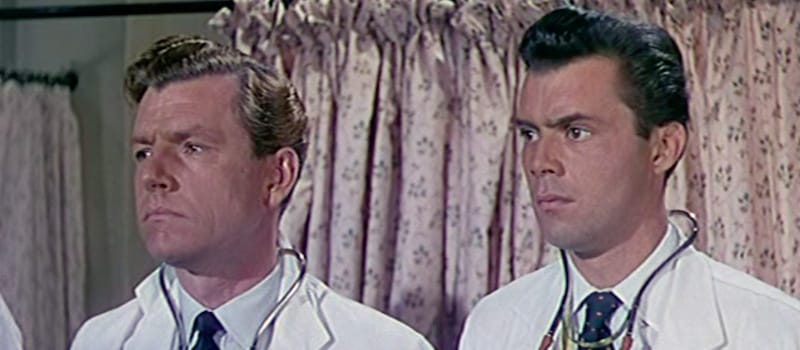Doctor in the House (1954)

Doctor in the House is the first in a series of seven Doctor movies made with more or less the same cast and crew, all based on a popular British series of comic novels by Richard Gordon. The film was notable for launching the career of a young Dirk Bogarde who had, until then, been seen mostly as a supporting actor in smaller British features. Movie-goers, particularly women, loved his quiet, understated turn as the dashing doctor, Simon Sparrow, a role he reprised in three of the six sequels.
Although there are strong links to the Carry On films—director Thomas is the brother of Carry On director, Gerald Thomas, and many of the cast and crew appear in both series—it would be wrong to assume that the Doctor films were an early version of Carry On Matron. Whereas much of the humour in the Carry On films depends entirely on innuendo and a little bit of smut, the Doctor films show a gentler side, reliant on character, charm and the occasional bad pun:
Simon Sparrow: I wonder if you could help me? I’m a new medical student.
Doctor: Really? Well, I’m a very old doctor.
The film follows Simon and his three friends—the feckless Grimsdyke (More), rugby-mad Taffy (Houston) and ladies’ man, Benskin (Sinden, who looks astonishingly young and dashing)—as they work their way through St Swithin’s Medical School. Or, in the case of Benskin, the nursing staff of the hospital. They are fortunate throughout to have fearsome surgeon, Sir Lancelot Spratt (James Robertson Justice), on their side, as they have several run-ins with both the Dean of the Medical School (Geoffrey Keen) and the Head Matron of the hospital.
Alongside more pressing concerns—such as the study of anatomy and the impact of decent sewerage on the public health of the nation—Simon encounters the landlady from hell (Joan Hickson) and her nymphomaniac daughter (Shirley Eaton, who was memorably killed by gold paint in Goldfinger). He also half-heartedly romances a wealthy older woman (the irrepressible Kay Kendall), even though his heart belongs to young nurse, Joy (Pavlow).
Although a few of the jokes are dated, most still hit the mark because, frankly, medical students haven’t changed much in sixty years. Many of the hospitals in which they ply their trade haven’t changed much either, but that’s another matter. You actually care about these characters. They’re not teenage idiots. In fact, most of them are way too old to be entering medical school. And only Grimsdyke, who’s spinning out his studies so he continue to profit from his grandmother’s trust fund, has an excuse for this.
But, although the audience is rooting for young Doctor Sparrow, there’s one character in the film who towers above all others in a very literal sense. That is, of course, James Robertson Justice as Sir Lancelot Spratt, the head of surgery. This is a man who does not suffer fools gladly and is not afraid to call a spade a shovel. His booming voice and larger-than-life character enlivened all seven of the Doctor films, as well as unofficial spin-off, Raising the Wind (imagine Doctor in the House set in a conservatory of music, rather than medical school).
The role—and his success in it—effectively typecast Robertson Justice and he spent the remaining 20 years of his life playing variations on Sir Lancelot. Of course, as a fiercely intelligent, unconventional man himself—he fought against General Franco in the Spanish Civil War with the International Brigade and was a major authority on ornithology, among other things—who was both confident and uncertain at the same time, he was ideally suited to the part.
Doctor in the House was the number one film at the UK box office in 1954, seen by almost half the population. It was nominated for four BAFTAs, including Best Film and Best Screenplay; Kenneth More won Best Actor.